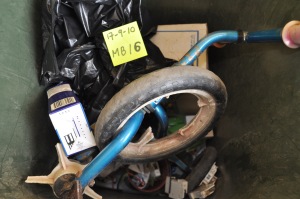Disposal – the less sexy twin of acquisition
Going back ten years, most households in Australia had a single ‘rubbish’ bin and, if they were lucky, another bin (or a plastic box in my household’s case) for glass and paper recycling. Today, I have an organics bin, a land fill bin (ie old ‘rubbish’ bin), a recycling bin as well as a kitchen caddy where I collect food scraps that I can place into the organics bin. My landfill bin has shrunk to half its original size while my recycling bin has doubled. This is an effective way of visually encouraging me to use the new bin system choices I have been given and also a means by which to physically limit me from old disposal habits.
As a researcher with an interest in waste, I love to keep abreast of such changes in my disposal options. But I am not normal. For the average person, disposal of ‘stuff’ is a routine, low involvement, problem solving behaviour. It’s the less sexy twin of acquisition. It is probably about as exiting as making a bed or brushing teeth and we give it about as much attention. We learn the basic disposal rules (which bin for what) when we are young, through watching our parents and when we help out with chores. I think that is where we strike a problem. It’s the sort of behaviour that you learn and then think “I’ve mastered that for life. I am an educated bin user”. A real challenge for the waste industry is to get householders to understand that, as technology changes, so too should disposal behaviours. There is a high level of habit (I’ve always put tea bags in the landfill bin) and misplaced householder perceived expertise (I’m sure I recycle everything I can) that we have to battle against to get people to use their was options effectively. And it’s important that we do. Things should not go to landfill that can be recycled. But also things should not go in the organics or recycling bin that cause contamination. That you can put clothes in the recycling bin and garden equipment in the ‘green’ organics bin (it’s about gardening isn’t it?) are examples of two common misperceptions that cause significant contamination. Yet it is not really fair to blame the householder. What feedback do they get on the decisions they have made at the bin? What rewards do they receive for their efforts to traipse to the recycling bin outside for the used paper towel roll rather than tossing it in the landfill bin under the sink? None.
I secretly harbour (not so secret now I’ve written about it) a desire to put a gold star and a black skull on bin lids and light one of them up after bin collection to create a feedback loop for the household. Gold star if you have not contaminated, skull if you have. Currently our disposal decisions are private, but imagine the shame of having a black skull glowing on your bin for a week for the neighbours to see! I’m being facetious. But the important challenges remains of how to get the message across that disposal behaviours should change with technology and to provide feedback loops for householders on their disposal decisions. Marketing has a strong role to play in achieving this.
